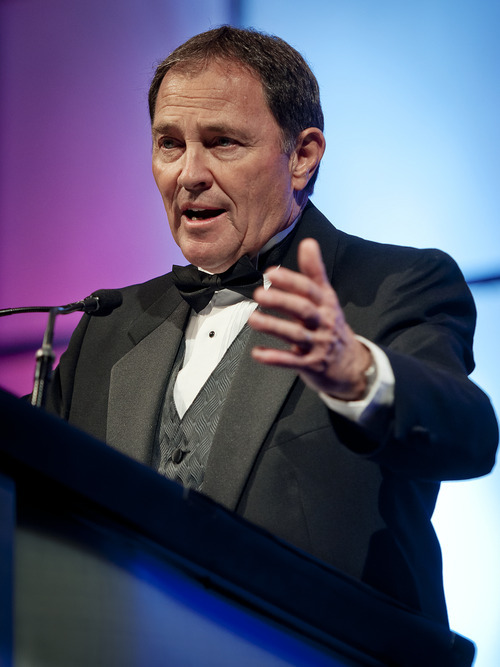This is an archived article that was published on sltrib.com in 2012, and information in the article may be outdated. It is provided only for personal research purposes and may not be reprinted.
Gov. Gary Herbert capped his 2012 Health Summit with a personal challenge to state employees: Get off the couch and lose some weight.
"We can lead by example," the Republican governor said, underscoring how better health — and lower health costs — largely hinge on decisions we make outside the doctor's office.
"Too many of us are couch potatoes. We can do more and watch less," he said. "True health reform boils down to not just policy and what we ought to be doing through government, but what we do through our own personal responsibility."
Herbert's 10-week "Choose Health" challenge — which urges Cabinet members, public workers and lawmakers to compete in adopting healthy behaviors — wasn't the only initiative showcased. For the summit's 500 attendees, Herbert recapped strides made on homegrown reforms started years ago, from the nation's second online insurance marketplace to a data superhighway that allows doctors around the state to share patient histories.
But on the topic of implementing federal health reform, Herbert stayed mum, reiterating that he's waiting until after November's election to make key decisions, such as whether to expand Medicaid to cover more of the state's poor.
"The election will have a lot of influence on the direction this country takes," he said. "My No. 1 focus is growing the economy. If we can get that right, everything else falls into place. We can all afford health care."
But for at least one attendee, Utah's fixes are too little, too late — and federal health reform couldn't happen soon enough.
Emily Young had been employed and fully insured for 22 years before she was laid off from her job at a Midvale software developer in May 2009. Five months later, she was diagnosed with breast cancer.
She was able to afford to continue her health benefits through a federal program called COBRA, which covered her surgery. But before she could undergo chemotherapy and radiation, her coverage under the Consolidated Omnibus Budget Reconciliation Act expired.
She applied for private insurance and was denied due to her cancer.
"I couldn't afford the tens of thousands of dollars for treatment. And I couldn't reach out to my family. I'm the sole caretaker for my parents," said the 43-year-old Bountiful native. "So I did a lot of soul-searching and job hunting and hoped for the best."
Young participated in a business start-up and, four months ago, landed a job at a two-person investment firm.
It doesn't come with health benefits, though. Last month she received more bad news: A biopsy of a small lump on her back shows her cancer has spread.
"It makes me angry and sad," said her family practitioner, Ray Ward. "Here's someone who may well die in her 40s because she doesn't have coverage, and through no fault of her own. The cracks in the system opened wide and at the wrong time for her."
Young went to the summit to urge policy leaders to adopt the expanded version of Medicaid, which would cover her.
In Utah, single adults with no kids, no matter how poor, aren't eligible for the low-income health program. The 2014 expansion, largely funded by the federal government, would change that and would raise the poverty threshold to cover a third of the state's uninsured, about 114,000 people — costing Utah $1.2 billion during the next decade.
"For the state, it's all about budgets and the bottom line. I wanted them to hear the other side," Young said. "I did everything right. I went to college and got my MBA, bought a house and worked my whole life. I'm not the demographic said to abuse the system. But now I need help."
Utah isn't without options for people such as Young. The state has two high-risk pools, insurers of last resort for people with pre-existing conditions. But the coverage doesn't come cheap, and, until Tuesday, Young didn't know it existed.
The governor acknowledged his 10-week challenge "won't solve all our health care problems." But wellness has to be part of the equation, he said, ticking off these statistics.
• Seven of 10 deaths in the U.S. are caused by chronic disease.
• An estimated 1.6 million Utah adults (60 percent) are overweight or obese.
• Each year, 39 million workdays are lost to obesity-related illnesses in the U.S.
Herbert started his own challenge ahead of most. At a makeshift clinic staged in the Grand America Hotel by the state's Public Employees Health Plan, the governor weighed in and had his vitals checked.
His blood pressure and cholesterol are within healthy range. At 170 pounds, he's far from overweight.
But by cutting out soda, running extra miles on the treadmill and playing more tennis, he hopes to shed 5 pounds and some body fat. "I feel pretty good,"he said. "But we can all do better." —
What would Utah's health reform plan do?
Gather consent from patients to populate a data superhighway that will allow a doctor in Moab to share critical patient information with an ER in Salt Lake City.
Steer low-income Medicaid patients into Accountable Care Organizations, which pay doctors to keep patients out of the hospital instead of just for services billed.
Upgrade the state's online-insurance shopping tool, one of the nation's first health exchanges.
Continue with tort reforms to stop frivolous medical-malpractice lawsuits. —
Utah's 'Choose Health' challenge
The self-paced challenge is tailored to employees' individual fitness goals. The winners will be the state agencies that receive the most points for making wellness part of the workplace, such as organizing lunch walks and promoting cookie-free lunches. Learn more about the program online.
> healthyutah.org/programs/hc.php



